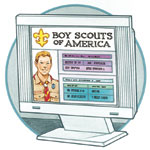
News Briefs
STEVE FOSSett, 1944-2007 -- Tribute to a Faithful Scout
Steve Fossett, an American business leader, adventurer, and president of the National Eagle Scout Association (NESA), embodied the spirit expressed in Henry David Thoreau’s statement about the life well lived. Wrote the famed author, “We should come home from adventures, and perils, and discoveries every day with new experience and character.”
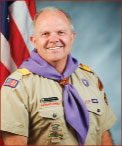 Fossett possessed plenty of both. He had returned from so many perilous endeavors that in September 2007, when his single-engine plane disappeared into Nevada’s desolate, desert landscape, friends, family, and the entire Scouting organization were stunned that, this time, “an Eagle who soared” had not come home.
Fossett possessed plenty of both. He had returned from so many perilous endeavors that in September 2007, when his single-engine plane disappeared into Nevada’s desolate, desert landscape, friends, family, and the entire Scouting organization were stunned that, this time, “an Eagle who soared” had not come home.
After all, Fossett set 115 world records or world firsts. He circumnavigated the globe in a hot air balloon, the first person to achieve such a feat. He soloed in a plane for 67 hours around the world without refueling. He swam the English Channel. And he survived a 30,000-foot fall in a damaged balloon.
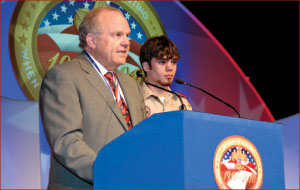 Fossett introduces NESA scholarship winner Patrick K. Smith at the BSA's national meeting last year in Atlanta. |
Fossett also set records for speed sailing, crossed the finish lines at both a Boston Marathon
and an Ironman Triathlon in Hawaii, climbed some of the Earth’s tallest peaks, and mushed through treacherous terrain on the grueling Iditarod Trail Sled Dog Race.
So when he lifted off from the Flying-M Ranch near Smith Valley, Nev., on a routine flight to scout locations for a planned attempt to break the supersonic land-speed record, who could have guessed such a man of achievement would simply, at the age of 63, vanish?
Fossett’s fellow aviation-record holder Dick Rutan has said that his friend wanted to be known as an adventurer. Certainly this was true from the time the Jackson, Tenn.-born Fossett joined the Boy Scouts at the age of 12 in his adopted hometown of Garden Grove, Calif. At that age, he climbed his first mountain.
“I just kept going,” he recalled later, “taking on more diverse and grander projects.”
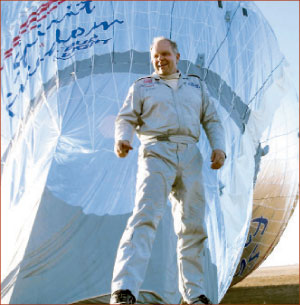 Fossett became the first person to circumnavigate the globe on a solo balloon flight in 2002. |
He credited Scouting with teaching him to dream big, challenge the limits, and constantly test his courage.
That knowledge came in handy after he earned a B.S. from Stanford University and an M.B.A. from Washington University in the 1960’s. Fossett applied what he’d learned in school to launch his career with IBM and later become a successful commodities broker on the Chicago Board Options Exchange. The aggressiveness he’d acquired in adven ture sports didn’t hurt his prospects, either.
Though Fossett subsequently made a fortune after founding the trading firms Marathon Securities and Lakota Trading, which helped finance his record-breaking adventures, he never abandoned the organization that inspired his outsized dreams.
Over the years, he attained many impressive milestones in the Scouting program, including Eagle Scout, Order of the Arrow lodge chief, Silver Buffalo Award recipient, Distinguished Eagle Scout, and the Order of the Arrow’s Vigil Honor.
In addition, Fossett served on the BSA’s National Executive Board, as chairman of the national Venturing Committee, on the board of directors of the Chicago Area Council, and, most recently, took over at NESA from Robert Gates, who was appointed U.S. Secretary of Defense by President George W. Bush in 2006.
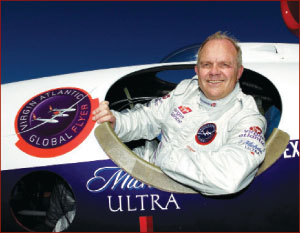 Piloting the Virgin Atlantic Global Flyer, Fossett makes the first solo, nonstop plane flight around the world without refueling. |
“I learned my values in the Boy Scouts,” Fossett said, “and I am proud of that.
”It was in the Scouts that I climbed my first mountain, and where I learned my leadership skills between the ages of 11 and 18.” And despite his apparent penchant for taking chances, the self-proclaimed adventurer always adhered to Scouting’s main tenet: “Be prepared.”
Fossett meticulously planned each of his daring feats. Virgin Air founder Richard Branson recalled in a Time magazine article Fossett telling him:
“People often assume I am a thrill seeker, but I am not. I do not enjoy roller coasters, and you won’t find me bungee-jumping. … It is a disadvantage that my pursuits are inherently dangerous. A large part of my effort is to reduce the risk.”
Since September, Fossett’s family, friends, and Scouting colleagues have wished he would come home to them. Now, Fossett’s wife, Peggy, plans to invite them to a memorial service for her husband April 22, which would have been Fossett’s 64th birthday, to honor a life well lived.
APril is Youth Protection MOnth
Would your Scout successfully respond to this new requirement for First Class rank: Describe a cyberbully and how you should respond to one.
 Though the media have reported extensively on the harmful affects of such behavior, and a recent study suggests that 30 percent of adolescents report incidents of online harassment, many people still don’t know how best to address this issue.
Though the media have reported extensively on the harmful affects of such behavior, and a recent study suggests that 30 percent of adolescents report incidents of online harassment, many people still don’t know how best to address this issue.
Because the BSA has designated April as Youth Protection Month, now’s the time to learn. Local Scout councils, units, families, and community organizations all across America will offer training to help deal with all types of abuse.
Cyberbullying, according to high-tech author and Internet safety advocate Larry Magid, represents the same type of anti-social cruelty that can take place in school hallways, in a locker room, or on a playground—except it happens electronically, in an e-mail, on the Web, via text message, or on a cell phone.
What can be done about it? The danger for adults, says Magid, is if they try to impart a “do-this”or “don’t-do-this” solution, and it becomes just another parental lecture.
“The best intermediaries are the kids themselves,” he advises. “If a parent or leader has another young person who can intervene, a popular kid whom everyone looks up to, he can make it clear to his colleagues that cyberbullying just isn’t cool.
“It’s lame to engage in that activity.”
Here, Magid offers some proven tips for short-circuiting even the most persistent cyberbully:
- Try not to let the teasing get to you. A mean message says a lot more about the person saying it than the person it’s directed to.
- Avoid responding to bullies. It only encourages them.
- Don’t delete harassing messages. Save them in case it’s necessary to take legal or other action.
- Use peer pressure. If other kids let the bully know that the activity is uncool, it might stop. But if that doesn’t work, tell a trusted adult and evaluate if it might be necessary to bring in school officials or the police.
- Consider using blocking mechanisms to stop e-mail, text messages, or social networking profile visits or comments from anyone who is rude, obnoxious, or is teasing or bullying you.
- Report serious threats to authorities. That could be a case where the bully has violated the law and authorities might be able to intervene.
For more information on cyber safety, log on to www.connectsafely.org, get Magid’s most recent book, MySpace Unraveled: A Parent’s Guide to Teen Social Networking,” contact your local Scout council for Youth Protection Month training, or go to www.scouting.org.
ROCKWELL and Csatari: A Tour de Force
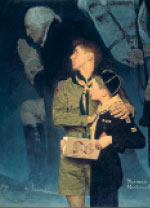 "Our Heritage" (1950) |
Never seen an original Norman Rockwell painting up close? This may be your chance.
See 10 eye-popping examples of Rockwell’s genuine Americana when the 2008 Year of the Volunteer Endowment Art Tour debuts in April in New Orleans—the first stop on a 12-city U.S. tour.
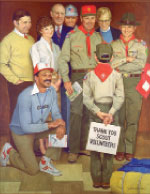 "Thank You, Scout Volunteers" (1983) |
A collaboration between the BSA Foundation and the National Scouting Museum in Irving, Tex., the exhibition features well-known works that portray volunteer leaders’ pivotal role in delivering the Scouting experience. It features original works by Rockwell, the distinctly American painter and illustrator known for creating iconic everyday scenarios, as well as artwork by Joseph Csatari, a realist painter and illustrator who studied with Rockwell.
It’s a feast for fans of Rockwell, who held his first and only salaried position with the Scouts from 1913 to 1916 but whose association with the BSA continued for 64 years. The exhibit displays some of the master’s most famous images.
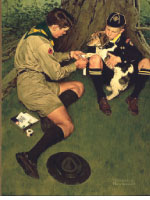 "Friend In Need" (1949) |
“The Scoutmaster” (1956), a sentimental favorite of many Scouts and a highlight of the collection, depicts a scoutmaster thoughtfully gazing into the embers of a dying campfire while his Scouts rest peacefully in their tents behind him.
Don’t miss other inspirational Rockwell works such as “Our Heritage” (1950), depicting two Scouts gazing at a painting within a painting—an image of George Washington praying at Valley Forge, and “Friend In Need” (1949), in which a Boy Scout and Cub Scout are shown administering first aid to a dog. “To Keep Myself Physically Strong” (1964) represents the more humorous style Rockwell used for his famous Saturday Evening Post covers. The work encourages physical fitness, portraying a Cub Scout perched on a chair measuring the chest of a more mature Scout—perhaps an older brother—who still hefts his workout equipment.
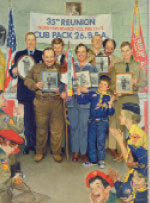 "The Reunion" (1979) |
Csatari, who took over the annual Brown & Bigelow calendar paintings from Rockwell in the 1970’s, updated the master’s Scouting themes with acclaimed works such as “Thank You, Scout Volunteers” (1983), “Values That Last a Lifetime” (1986), and “The Reunion” (1979), which in a single image illustrates various life paths taken by an aging group of former pack members. All appear in
the exhibition.
Catch these classic artworks in New Orleans; Oklahoma City; Des Moines; St. Charles, Ill.; Detroit; Roanoke, Va.; Pittsburgh; Salt Lake City; Seattle; Milford, Conn.; Florham Park, N.J.; and Phoenix. For more information, including dates for special, by-invitation events, contact host councils and councils from the surrounding geographic areas.
New Ripples in Water Safety
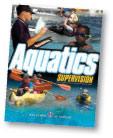 Don’t let your Scouts take the plunge without reading and referencing the new leaders’ guide to BSA aquatics.
Don’t let your Scouts take the plunge without reading and referencing the new leaders’ guide to BSA aquatics.
Due in April, Aquatics Supervision: A Leader’s Guide to Youth Swimming and Boating Activities, serves as an invaluable resource for learning the roles and responsibilities of council aquatics committees, provides support to unit leaders so they have the training and resources necessary to supervise swimming and boating activities, and gives direction for dispensing special aquatics awards such as Snorkeling BSA and Boardsailing BSA.
Approved by the national Health and Safety Committee and BSA’s national Program Committee, the eight-hour courses include “Swimming and Water Rescue”; teaching prevention, recognition, and response to water-related emergencies; and “Paddle Craft Safety,” offering assessment tools for individuals supervising canoe or kayak float trips.
The guide, BSA No. 34346, also instructs volunteers who are trained by other agencies, including the American Red Cross and the American Canoe Association, in appropriate Scouting protocols and programs.
Listen and learn with 'Cubcasts'
If you’re a Cub Scout leader or parent seeking how-to’s and program resources, simply grip your mouse and click. “Cubcasts” are one of the Cub Scout Division’s newest tools, available to provide timely resources to the field.
 Actors Kristin and Robert McCollum serve as M.C.s for monthly Cubcasts, which feature program theme information, tips from top Cub Scouting volunteers, and prizes. |
In December 2007, for example, the Cubcast featured Cheri Pepka, the Chief Seattle Council’s Cub Scout roundtable commissioner, discussing additional ideas on how to use January 2008’s Cub Scout Car Show program theme.
“Virtually every Cub Scout volunteer can get something useful out of the Cubcasts,” said Peter Simon, who produces and scripts the programs. “Everybody is super busy these days, and Cubcast is a way to cut through the information clutter and help our volunteers focus on the themes and issues important to their den and pack.”
Got an idea? Simon says the Cubcast crew is always looking for content. Past topics have included safety, camping, leader training, youth protection, and the religious emblems program.
“One of the beauties of this new media form,” he says, “is that we give out an e-mail address where listeners can offer us feedback and suggestions. Just drop us a line at cubcast@netbsa.org.”
You’ll need podcast client software to manage the files and play the audio. Many brands are available, some free of charge. Search the Internet for “podcast client” to find information and links for downloading this software.
Hear the first 10 months of podcasts, since April 2007, at www.scouting.org/cubscouts/podcast.
WATCH AND EARN
Volunteers seeking to earn a Centennial Quality Award in 2008 have a new tool for success.
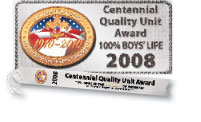 The BSA’s Leadership Support Service has created a special DVD that provides assistance for each “quality program indicator,” as well as examples of how to interpret the criteria and establish and achieve the goals to win.
The BSA’s Leadership Support Service has created a special DVD that provides assistance for each “quality program indicator,” as well as examples of how to interpret the criteria and establish and achieve the goals to win.
Access the video by clicking on “Site Map” at www.scouting.org. Click on “C” and scroll down to “Centennial Quality Awards Program.” The video also is available under the “Centennial Quality Awards Program” tab on the commissioner’s Web site at www.scouting.org/commissioners.
After watching the video, download the fill-in commitment and achievement forms to complete immediately, save for later, or send electronically to others as needed. A set of informative, frequently asked questions (FAQs) offers additional information.
The Centennial Quality Award recognizes units, districts, councils, areas, and regions for achieving excellence in providing a quality program at all levels of the Boy Scouts of America. The vision of the program is “To improve the quality of program in every unit in America!” There are special recognitions for the unit, the leaders, and the youth who qualify annually for the Centennial Quality Award. .